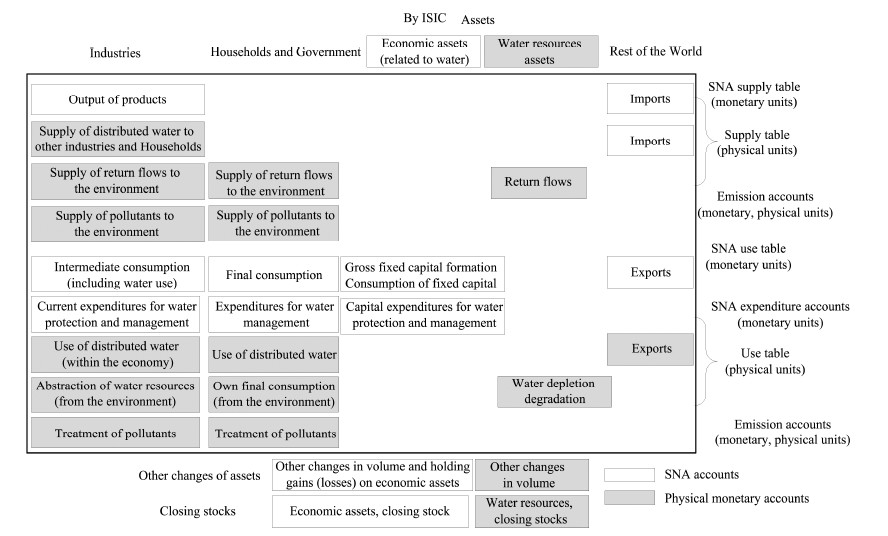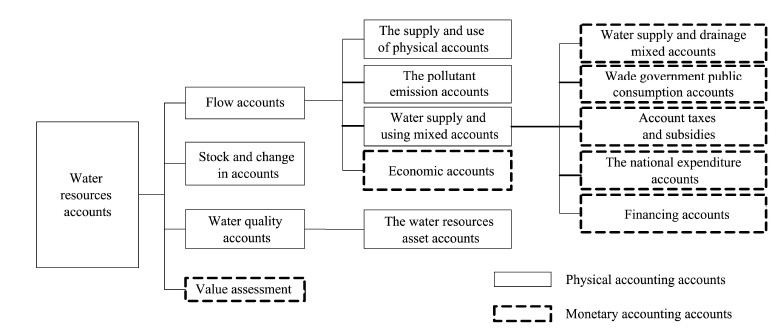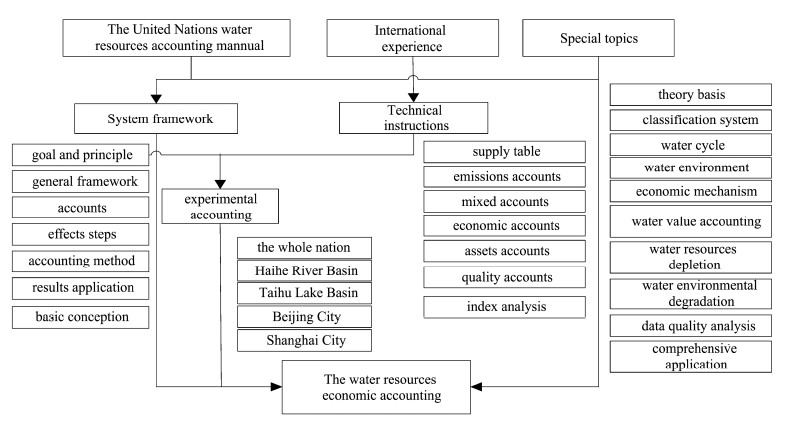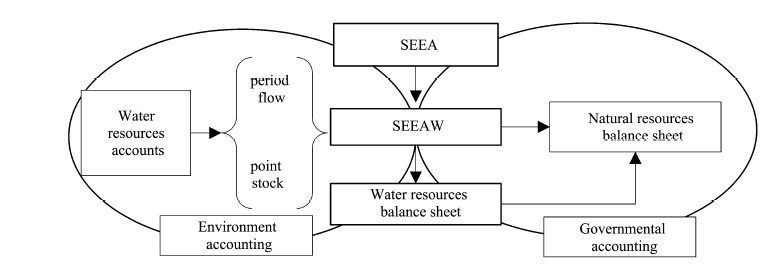Article Information
- FuHui Jian, XiaoYu Song, LiLi Li, WenQi Gao. 2016.
- The evolution and enlightenment of water resources accounting from accounts to balance sheet
- Sciences in Cold and Arid Regions, 8(2): 156-162
- http://dx.doi.org/10.3724/SP.J.1226.2016.00156
Article History
- Received: August 30, 2015
- Accepted: December 30, 2015
2. Gansu's Economic Research Institute, Lanzhou, Gansu 730000, China;
3. University of Chinese Academy of Sciences, Beijing 100049, China;
4. Lanzhou University of Finance and Economics, Lanzhou, Gansu 730020, China
1 Introduction
Under the current high-speed regional economic growth in China,thepolitical promotion tournament model has brought serious resources and environmentalproblems. The Third Plenary Session of18th CPC Central Committee issued a decision of "accelerating the processof setting up a unified national economic accounting system,formulating national and local balance sheets,implementing leaders' of-office auditing system ofnatural resources assets, and establishing ecological damage liability lifelong accountability system"(The Third Plenary Session of the 18th CPCCentral Committee,2013). The natural resourcesasset balance sheet will be linked to natural resources conservation and officeholder'sachievement,as reform performance assessment model,strengthens the"green constraint" practical basis(Feng et al., 2015). Thus,establishment of the natural resources asset balance sheet can optimize the government'smacro accounting system,guide environmental damage and ecological benefit intothe evaluation system of social development. This system is important for solvingproblems in the current national economic accounting system. Setting up theresources sub-categories is an effective way to objectively obtain resourcesquantity,quality, and utilization conditions, and to evaluate resourcesdepletion and environmental degradation caused by resources development and utilization(Gan,personal communication,2015; Xue et al., 2015). Waterresources balance sheet can record water resources stock assets and changes,comprehensively account for possession,use and consumption for each economicindividual, and reflect recovery and value-added water resources assets duringa certain period(Feng et al., 2014). On this basis,the balance sheetcan evaluate water resources assets changes in respect to physical and monetarymeasures, and reflect the degree of ecological environment destruction or restoration(Gan et al., 2014; Chen et al., 2015). In this paper,we introducethe concept and function of the System of Environmental Economic Accounting forWater(SEEAW),then describe the evolution of SEEAW in detail. Finally,therelationship between water resources accounting and water resources balancesheet account is explored, and some principles and key issues on compiling thewater balance sheet are put forward for promoting and optimizing the water resourcesbalance sheet system.
2 The definition and function ofSEEAWThe system of environmental economic accounting for water(SEEAW)provides a link between economic information and hydrological information by compilingwater resources and water economy accounts,providing users with a valuableconceptual framework agreement,comprehensive analysis tools, and the basisplatform for macro decision establishment(Gan and Gao, 2008). SEEAW is basedon a set of interrelated accounts,including physical supply use tables,waterassets,emission,water quality,mixed and economic accounts,reflectingnational economic sectors of water use,water supply,water sewage,water wastetreatment,as well as national economic output and input associated with watersupply(Deng and Gan, 2009). These accounts established a direct relationshipbetween the Chinese economy and water resources physical quantity,providing adetailed overall database for water resources and national economic activity(Qin and Gan, 2010).
3 International and domestic practice of SEEAW 3.1 Internationalpractice 3.1.1 Water accounting framework in UnitedNationThe most widely used water resources accounting system was publishedby the United Nations Statistics Division,which was based on System of IntegratedEnvironmental Economic Accounting(SEEA). In the beginning,SEEA-1993 version didnot include the contents of water accounting,mainly focusing on the morecomplex statistics on natural and social economic duality property of waterresources,but lacked unified researchdefinitions and classifications of nations(United Nation,1993). In order to solve these problems,the UN Statistical Division established the London Group on water environmentalaccounting packets in November 2003,to prepare the water environmental economicaccounting accounts(United Nation,2003). With efforts of the working group,"thewater environmental economic accounting system" was published in 2007(UnitedNation, 2006a,b,2007). SEEAW of UN was constantly being improved through theSEEA Central Framework. The United Nations Statistics Division and the LondonGroup on Environmental Accounting jointly compiled "SEEA-Water(2012)"in 2012. In comparison with the previous versions,this version published in 2012had more clear accounting ideas to meet the format and requirements of economicaccounting, and had more objective measuring methods to better reflect therelationship among environment,ecology and economy. Results of the UN researchwere divided into two st and ard categories: universal and below-universal,whichhas further increased the operability of water resources accounting(UnitedNation,2012).
Figure 1 clearly shows the SEEAW accountingframework of UN. The white rectangles represents monetary accounts(accountmeasured with monetary unit),which were adopted into the SNA system directlyor indirectly; the shaded rectangles were involved in the SEEAW accountingframework but were not in the SNA system. With SEEAW,the situation of initialwater stock is well understood based on water resources assets accounting,economic and social water resources exploitation based on current water supply and utilization accounting,sewage and pollution emission based on informationof discharge and recycling. In combination with information of precipitation,evaporation,inflow and outflow processes,we can obtain the end waterresources stock,further achieving integration with the SNA system. The water resourcesaccount system in UN framework includes two categories of accounts,physical and monetary accounting accounts(Figure 2; United Nation,2012).
 |
| Figure 1 SEEAW framework of UN |
 |
| Figure 2 The system of water resourcesaccounts in the United Nations |
Compared with other countries,Australia has two managementsystems in water environmental economic accounting: one is Australia Environmental-Economic Accountsfor Water based on SEEAW,formulated by the AustralianBureau of Statistics(ABS),for policy application and macroscopic decision,the latest version is AEEAW2014; the other is Australia Water AccountingSt and ard(AWAS),formulated by the Australian Bureau of Meteorology(BOM),mainly focusing on the target of water management and promoting water accountingst and ards.
1)Water accounting system of ABS
This framework is based on the development of SEEAW in the UnitedNations. There are two components: the first part is the best way of consensusreached by the international practical experience,including global consensus,definitions,classifications,accounts and tables; the second part is inaccordance with relevant policies, and is in the experimental stage because thebest acceptable international practice has not yet appeared. AEEAW does notentirely follow the traditional quantization table of SEEAW,where the water accounting framework formatconsiders thephysical characteristics of Australian water in nature(Australian Bureau of Statistics, 2004,2006,2007,2008,2014). Currently,the Australian Water AccountingBureau of Statistics still focuses on physical accounting and less on valuecalculation.
2)Water accounting system of BOM
AWAS needs all water use sectors to providetheir relative accounts so as to disclose their water assets,water debt, and water flux conditions during the accounting period. The accounting period herecan be days,weeks,or years; each sector's water statistics can be progressivelyadded,finally,producing a general accounting statements of a province and nation(Australian Bureau of Meteorology,2009). In October 2010,the latest"water resources accounting st and ard" was published for accountingthe stock and flow of water resources in financial accounting(Australian Bureau of Meteorology,2010). At present,only Australia has taken it intoconsideration the physical volume of water resources in the balance sheet,which reflects water ownership within economies,but does not response the debtrelationship between economy and environment(Australian Bureau of Meteorology,2014).
3.1.3 Water accounting system in NetherlandsThe Netherlands water accounting system has become an import antbasis for social welfare indicators. At the beginning of formulating water accounting system,the European Union drew many lessons from the concepts and definitions of social and economic water resources accounting of the Netherlands. Water resources accounting mainly includes human consumption ofvarious quality of water resources,economic sectors' discharge into the waterenvironment and its measurable influence on water quality,as well as wastewater treatment and resulting costs(Keuning et al., 1999). This accounting system notonly pays attention to the relationship of transformation between natural waterresources and social economic water resources,but also focuses on the impactof human activity on the natural water resources environment. The Netherlands accounts system for water accounting,including 12 tables,are represented by physical units other than monetary units,by which the data of integrated water resources and its utilization,waste water emission, and production payment price are calculated(Huang and Zhao, 2015).
3.2 Domestic practice ofSEEAW 3.2.1 IntheoryThe theoretic research of SEEAW in China was initiated during thelate 1980s. The Chinese Ministry of Geology and Mineral Resources associatedwith Jilin University developed a study on resources accounting in 1987,includingwater resources accounting and sub-national economic accounting systemresearch. JinChang Li(1991)put forward a theoretical resources accountingframework. WenLai Jiang(1998)discussed the constitution of water resourcesprice from different angles. ShuManWang(2001)illustrated that water quality wasthe core of water resources value accounting. DongJing Chen et al.(2003)made a simple economic environmental accounting for water resources in theZhangye City, and had established physical,value,industrial allocation ofdepletion cost, and integrated industry accounts. AiHua Long(2004)establishedthe Heihe River water accounts at the irrigation and farml and scales. YanQin Lv(2004)provided an accounting framework model for water resources in an aridregion from macro and micro angles. Hong Gan et al., in 2008,2011,2012, and 2014,had enriched and improved the water resources accountingsystem of China,conducted an exploratory study on water resources depletion and environmental degradation costs, and put forward an environmental and economic accounting framework of water resources of China. In addition,numerous researchers had made similar studies in China(Qin and Gan, 2010; Zhao,2010; Jia,2012; Ma et al., 2012,2013).
With the deepening of water resources accounting in China,relatedtheories and methods are becoming more advanced. From the view of water accountingcontent,domestic studies focus mainly on water resources account construction and the estimation of water resources physical accounting,but value accountingof water resources is still waiting for exploration. At present,water accountingseldom emphases the aspects of water assets liability and how to build a linkbetween water resources accounting and water assets liability. From the aspect ofaccounting methods,physical accounting is the foundation,while valueaccounting is the core issue of water resources accounting system. Also,there are various valuation methodssuch as shadow price,supply and dem and pricing,fuzzy comprehensiveevaluation, and the CGE model. Due to the lack of st and ardized accounting methods,physicalaccounting is more frequently used than value accounting for current research.
3.2.2 InpracticeWith the technical assistance of the United Nations StatisticsDivision,China Institute of Water Resources and Hydropower Research,early in2005,jointly launched a research project on Water Accounting. Based on theSEEAW accounting framework of UN,the National Bureau of Statistics and theRenmin University of China,in combination with other departments,choosingBeijing and Shanghai as two pilot areas,the Haihe River and the Taihu Lake astwo pilot basins,established a water resources environmental economicaccounting framework(Gan and Gao, 2008; Ruan et al., 2012; Figure 3).The framework included water supply and use,mixing,emission,water stock and water flux,water management and economic accounts. Based on these accounts,wateraccounting was carried out with physical and monetary accounts. The results notonly provided basic information support for promoting water statistics and implementing the most stringent water resources management,but also provided practical experience reference for other departments(Xing and Dai, 2014).Nevertheless,at present,a unified accounting system and method has not beenset up. Hopefully,the Third Plenary Session of 18th CPC Central Committee hasmade decisions "to speed up the establishment of unified national economicaccounting system,to formulate local and national balance sheet of naturalresources,to set up the ecologicaldamage liability lifelong accountability system," which opens up new opportunities for promoting research on water resourcesaccounting of assets and liabilities.
 |
| Figure 3 Water resourcesaccounting framework in China |
1)From the historical evolution of SEEAW inUN and some typical countries,water resources accounting could be divided intothree stages:(1)1990-2003,the so-called infancy stage,focused on theestablishment of natural resources accounting accounts;(2)2003-2011,thefoundation stage,developed from theory to practice,especially the publishingof SEEAW-2003,water accounting began to interact with natural resourcesaccounting and traditional national economic accounting system;(3)since 2012,the practical stage,considering SEEAW-2012 as a symbol,the United Nations beganto carry out the establishment of water accounting with internationalst and ards, and recommended adoption by other countries.
2)From the aspect of accounting framework,wateraccounting system has been initially formed into a theoretical system,practicalexperience constantly revised and optimized. The framework of each country wasalmost similar with UN,the system is especially systematic in Australia,whichis carried out every four years from the beginning of 2000 and gradually formeda st and ard system. China has exp and ed the water accounting theoreticalframework and method, and has put forward water environmental economicaccounting,water resources depletion costs, and water environmentaldegradation. Other aspects that require further study include the reduction of waterconsumption and the negative effect of environmental water degradation into thenational economic accounting.
3)The water resources balance sheet isthe sub-table of the natural resources balance sheet,which aimed to providewater assets and water balance information for natural resources balance sheet ina country or region(Gan et al., 2014). A substitute or subordinate relationship does notexist between water resources accounting and water resources balance sheet,both of which areintended to gather importantwater resources information and reveal their changes during the accounting period. They alsohave different implications and foci. Water resources balance sheet reveals asituation of water resources within a certain time for a particular region orcountry,analyze dynamic changes of water resources assets,reflect theecological construction level for considering the relationship between waterassets and liabilities, and lay particular stress on accounting according tothe accounting equation. Water accounting mainly reflects a concept of waterflow in a period of time,adjusts the GDP accounting after the consideration ofresources depletion and environmental degradation, and lay particular stress on data statistics indicators. Waterresources balance sheet or the water resources accounting system both require a physicalmeasure of water resources accounts, and monetary measure are an importanttheoretical basis and data source(Huang and Zhao, 2015). The relationship amongwater accounting accounts,water accounting system and water balance sheets arepresented in Figure 4.
 |
| Figure 4 The relationship of water accounts,water accounting system and water balance sheets |
4)Whether domestic or foreign,compiling water resources balancesheet is a new field. According to search results from Springer,Elsevier and other full-text databases,direct reference theory,methods and experience are limited, and documents where the water resources balance sheetprecisely match is scarce. At present,most of the water resources accountingin China and abroad are waterassets accounting,which require study and discuss on how to define waterliability items. In addition,water assets accounting is not a unified system for the water resourcesvalue method,which is one of the difficulties for preparation of the water resources balancesheet. Scientific research is also greatly affected to a large extent by liabilities of the assets property rights system in China.
5)Due to water resources renewability,r and omness,mobility and other characteristics,the quantity and quality of water resources are changingin a particular time and spaceinteract.Therefore,based on the national,hydrological,water accounting conditions inChina,compiling water resources balance sheet should observe the followingprinciples: firstly,let the physical accounting ahead to the value accounting, and provide assets accounting before liability accounting,from exploration and research to program establishment,from pilot case studies to overall implementation,from st and ard formulation to developing institutional arrangements; at the sametime,pay attention to strengthening basic data collection and technical methodoptimization. Physical accounts of water resources assets have been firstlyestablished,under the premise to ensure a scientific index system and completedata,should provide valueaccounts in pilot areas and continuously optimize value accounting system of the waterbalance sheet.
Acknowledgments:This study was supportedby the Chinese Science Academy STS Program: Natural Resources Balance Sheet Research and Application(KFJ-EW-STS-001); National Natural Science Funds Key Project(Grant No. 91125019); National Natural Science Youth Foundation(Grant No.41401645). We would like to thank the editors and anonymous reviewers for helpfulimprovements.
| Australian Bureau of Statistics, 2004. Water Account for Australia.www.abs.gov.au. ABS Cat, No. 4610.0. |
| Australian Bureau of Statistics, 2006. Proposed Methodology for Producing Regional Water Use Estimates. www.abs.gov.au. ABS Cat, No. 4612.0. |
| Australian Bureau of Statistics, 2007. An Experimental Monetary Water Account for Australia. www.abs.gov.au. ABS Cat, No. 4613.0. |
| Australian Bureau of Statistics, 2008. Water Use on Australian Farms. www.abs.gov.au. ABS Cat, No. 4618.0. |
| Australian Bureau of Statistics, 2014. Australian Environmental Economic Accounts. www.abs.gov.au. ABS Cat, No. 4655.0. |
| Australian Bureau of Meteorology, 2009. Preliminary Australian Water Accounting Standard and Associated Model Reports.www.bom.gov.au/water/standards/wasb/shtml. |
| Australian Bureau of Meteorology, 2010. Exposure Draft of Australian Water Accounting. www.bom.gov.au/water/standards. |
| Australian Bureau of Meteorology, 2014. Water Accounting Conceptual Framework for the Preparation and Presentation of General Purpose Water Accounting Reports. www.bom.gov.au/water/standards/wasb/shtml. |
| Chen DJ, Xu ZM, Chen RS, 2003. Design of water resources accounts:a case of integrated environmental and economic accounting. Advances in Water Science, 14(5):631-637. DOI:10.14042/j.cnki.32.1309.2003.05.019. |
| Chen Y, Yang YZH, Yan HM, et al., 2015. Natural resources accounting and the natural resources balance sheet. Resources Science, 37(9):1716-1724. DOI:1007-7588(2015)09-1716-09. |
| Deng J, Gan H, 2009. Exploring a system of environmental and economic accounting for water. South-North Water Transfers and Water Science Technology, 7(2):29-32. DOI:10.3969/j.issn.1672-1683.2009.02.010. |
| Feng ZM, Yang YZ, Chen Y, 2015. National balance sheets and implications for natural resources balance sheet. Resources Science, 37(9):1685-1691. DOI:1007-7588(2015)09-1685-07. |
| Feng ZM, Yang YZ, Li P, 2014. From natural resources accounting to balance sheet of natural resources assets compilation.Chinese Academic Journal, 4(29):449-456. DOI:10.3969/j.issn.1000-3045.2014.04.007. |
| Gan H, Gao MX, 2008. Basis and thoughts on creating the system of environmental economic accounting for water(SEEAW) of China. Journal of Chinese Water, 17:1-5. |
| Gan H, Qin CH, Lu Q, et al., 2011. Study on calculation method of water resources depletion cost. Journal of Hydraulic Engineering, 42(1):40-46. DOI:0559-9350(2011)01-0040-07. |
| Gan H, Qin CH, Wang L, 2012. Study on water pricing method and practice1:Discussion on the connotation of water resources value. Journal of Hydraulic Engineering, 43(3):288-295. DOI:0559-9350(2012)03-0289-07. |
| Gan H, Wang L, Qin CH, et al., 2014. Understanding of balance sheet of water resources. Journal of Chinese Water, 14:1-7. |
| Huang RB, Zhao Q, 2015. Natural resource accounting evolution and enlightenment. The Theory and Practice of Finance and Economics, 36:74-77. DOI:10.16339/j.cnki.hdxbcjb. 2015.01.014. |
| Jia L, Qin CH, Gan H, 2012. Method for cost evaluation of the environmental degradation of water. Advanced Materials Research, 361-363:1627-1633. DOI:10.4028/www.scientific.net/AMR.361-363.1627. |
| Jiang WL, 1998. Value Theory of Water Resource. Beijing:Science Press, pp. 109-227. |
| Keuning SJ, van Dalen J, de Haan M, 1999. The Netherlands' NAMEA:presentation, usage and future extensions. Structural Change and Economic Dynamics, 10:329-341. DOI:10.1016/j.ecolmodel.2010.10.019. |
| Li JC, 1991. The Theory of Resources Accounting. Beijing:Maritime Press, pp. 10-20. |
| Long AH, 2004. Study on water resources accounting and socialization management-take Zhangye as a case. Ph.D. Thesis, Cold and Arid Regions Environmental and Engineering Research Institute, Chinese Academy of Science, pp. 5-27. |
| Lv YQ, 2004. Research on capitalization management of water resources in arid area-a case study of the Tarim River Basin.Ph.D. Thesis, Xinjiang University, pp. 20-60. |
| Ma Z, Long AH, Wang Y, 2013. Water Resource Environment Comprehensive Economic Accounting and Social Management Research. Beijing:Science Press, pp. 1-100. |
| Ma Z, Wang MM, 2012. The preparation of physical water supply table in Zhangye city-SEEAW preliminary application. Journal of Economics of Water Resources, 6:11-15. DOI:10.3969/j.issn.1003-9511.2012.06.003. |
| Qin CH, Gan H, 2010. Study on economic mechanism of water usage based on hybrid account in SEEAW. Journal of Hydraulic Engineering, 41(10):1150-1156. DOI:0559-9350(2010) 10-1150-07. |
| Ruan RL, Ruan DC, Zhang Y, 2012. Water Resources Statistics and Accounting System Research in Shanghai. Beijing:Science Press, pp. 6-20. |
| The Third Plenary Session of the 18th CPC Central Committee, 2013. Decision of the Central Committee of the Communist Party of China on some major issues concerning comprehensively deepening the reform(Nov. 15, 2013). http://www.xinhuanet.com/. Cited in Nov.15, 2013. |
| United Nation, 1993. Handbook of National Accounting on Integrated Environmental and Economic Accounting, Series F, No. 61. New York:United Nations Publication. |
| United Nation, 2003. National Accounting on Integrated Environmental and Economic Accounting. New York:United Nations Publication. |
| United Nation, 2006a. Central Product Classification(CPC) Version 2.0(Draft March 2006). New York:United Nations and United Nations Environmental Programme. |
| United Nation, 2006b. International Standard Industrial Classification of All Economic Activities Revision 4(Draft March 2006), New York:United Nations Publication. |
| United Nation, 2007. Integrated Environmental and Economic Accounting for Water Resources. New York:United Nations Publication. |
| United Nation, 2012. Integrated Environmental and Economic Accounting for Water Resources. New York:United Nations Publication. |
| Wang ShM, Qu FT, 2001. Water resources accounting and adjustment of GDP. Journal of Nanjing Agricultural University, 24(2):115-118. |
| Xing ZH, Dai JJ, 2014. Establishment of accounting system of water resources in Taihu Basin and pilot project study. China Water Resources, 3:26-28. |
| Xue ZC, Yan HM, Yang YZ, et al., 2015. Design and empirical study of a land resource accounting system for natural resources asset balance sheet compilation. Resources Science, 37(9):1725-1731. DOI:1007-7588(2015)09-1725-07. |
| Zhao W, 2010. Research on value amount of system of environmental economic accounts for water in Shanghai based on value flows theory. M.S. Thesis, East China Normal University, pp. 35-64. |
 2016, 8
2016, 8


